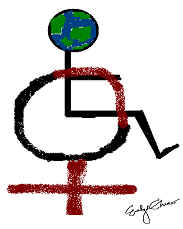|
|
DPI's Panel Discussion on Women with Disabilities
Evelyn Chow
August 2, 2005

When the sixth session of the Ad Hoc Committee's Convention on the Protection and Promotion of the Rights and Dignity of Persons with Disabilities recessed, a whole new discussion began to take place. Across the street from Conference Room 4, Disabled Peoples' International (DPI) was hosting a panel discussion on the Inclusion of Women with Disabilities in the UN Convention. DPI is "a network of national organizations or assemblies of disabled people, established to promote human rights of disabled people through full participation, equalization of opportunity and development"1. Their topic was, of course, women with disabilities (WwD), and their aims were (and are) to "fight discrimination [against WwDs,].to be more visible.[and] to have legally-binding official documents [that protect WwDs]". So says Dinah Radtke, DPI's Deputy Chairperson for Human Rights in Europe. Ms. Radtke, along with panelist Dr. Sigrid Arnate, a German journalist, agreed that women with disabilities face several violations of human rights. "[WwDs are] discriminated on many grounds.age[, for instance]. This issue will not be solved by itself," Ms. Radtke says.
The issue of protecting women with disabilities is further complicated by the many subsets within the categories of "women" and "persons with disabilities". In the U.S. alone, there are over 8.3 million women over the age of 65 with one or more disabilities2. How do you address such a vast number of vulnerable people? Women with disabilities, let alone elderly women with disabilities, already are "invisible" citizens faced with a plethora of problems; they are more susceptible to gender-based violence, injuries or deaths in armed conflict, poor living conditions, depression, selective abortion, forced sterilization, and inadequate education.
To combat these problems, DPI proposes a.) To institute a separate article toward the beginning of the UN document solely regarding women with disabilities, and b.) To form
articles especially for women with disabilities complemented by a gender perspective.
But WwDs, and
especially elderly WwDs, still have some ways to go before they are no
longer marginalized in UN Human Rights documents. As Ms. Radtke
admonishes, "we have to listen to the argument, we must develop our own
strategy and lobby together. We have unity and together we are strong."
As for the question of protecting and including elderly disabled women in
the UN's timely discussion of persons with disabilities, Ms. Radtke
states, "we try to respond to all needs and issues being raised and of
course we will address the issue of elderly women. I will take the
situation of elderly disabled women into account and work with it."
1 http://v1.dpi.org/lang-en/
2 U.S. Census Bureau. PCT26. SEX BY AGE BY TYPES OF DISABILITY FOR THE CIVILIAN NONINSTITUTIONALIZED POPULATION 5 YEARS AND OVER [101] - Universe: Civilian noninstitutionalized population 5 years and over
Data Set: Census 2000 Summary File 3 (SF 3) - Sample Data
1 = DPI website entry page
2 = Census bureau
|
|



